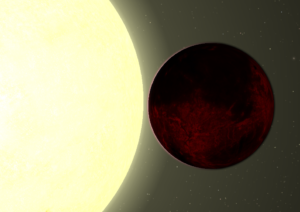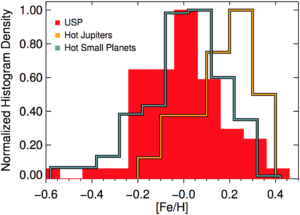
Artist’s conception of the ultra-short-period planet Kepler-78 b, discovered by Sanchis-Ojeda and colleagues in 2013.
An eyebrow-raising paper emerged recently from Prof. Josh Winn and colleagues about a type of planet near and dear to my heart, ultra-short-period planets, or USPs for short.
These planets are roughly the size of Earth and probably rocky but are hundreds of times closer to their host star than the Earth is to the Sun. These planets are so hot some have melted daysides and others are evaporating. Because they’re so much closer to their stars, ultra-short-period planets zip around their stars in just hours – hence the clunky name.
Our group, along with others, has suggested USPs might be the remnants of hot Jupiters (gas-giant planets close to their stars) that had their atmospheres ripped off. If so, we’d expect systems hosting USPs to resemble systems hosting hot Jupiters.
One distinctive feature of stars with hot Jupiters is that they have more iron (Fe) and other heavy elements in their atmospheres. Astronomers call the amount of heavy elements (“metals”) stellar metallicity. Hot-Jupiter host stars are heavy in metals probably because planets form from the same materials as the star and big planets need large amounts of metals to form. The same trend doesn’t seem to hold for small, roughly Earth-sized planets, though – small planets don’t seem to be as picky. So, if USPs are hot Jupiters that lost their atmospheres, their stars should also be metal-rich.

Figure 4 from Winn et al. (2017), showing the distribution of stellar metallicities for USP-hosting stars (red), hot Jupiter-hosting stars (orange), and stars hosting small but slightly longer period planets (blue).
But the recent paper from Winn and colleagues throws this origin story for USPs into doubt. In their study, they looked at metallicities for stars hosting USPs, stars hosting hot Jupiters, and those hosting small planets a bit farther out than USPs, all discovered by the Kepler Mission. The figure at left shows their results.
As expected, the orange curve for hot Jupiter hosts peaks toward higher metallicity (that is, toward bigger [Fe/H]-values), and if USPs are former hot Jupiters, the red histogram should look like the orange one.
Instead, it looks a lot like the blue one for smaller, farther out planets. This result suggests that USPs are just like their longer-period cousins – planets that have always been small, just with very short periods.
What to make of this? There’s some statistical wiggle room, allowing some, but not all, USPs to have been hot Jupiters, but Winn’s analysis says no more than 46%. It’s also possible that the boundaries between what Winn calls “hot Jupiters” and what he calls “hot small planets” could be refined by additional analysis, shifting the orange curve down a bit (or maybe shifting the blue curve up).
But the chances that USPs experienced a dramatic and brutal origin are a little slimmer now. Maybe that’s a good thing – it says the universe might be a little bit less violent than we thought.